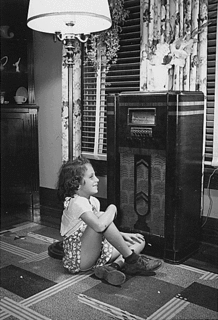
A sound effect is an artificially created or enhanced sound, or sound process used to emphasize artistic or other content of films, television shows, live performance, animation, video games, music, or other media. These are normally created with foley. In motion picture and television production, a sound effect is a sound recorded and presented to make a specific storytelling or creative point without the use of dialogue or music. The term often refers to a process applied to a recording, without necessarily referring to the recording itself. In professional motion picture and television production, dialogue, music, and sound effects recordings are treated as separate elements. Dialogue and music recordings are never referred to as sound effects, even though the processes applied to such as reverberation or flanging effects, often are called "sound effects".

An audio tape recorder, tape deck, or tape machine is a sound recording and reproduction device that records and plays back sounds usually using magnetic tape for storage. In its present-day form, it records a fluctuating signal by moving the tape across a tape head that polarizes the magnetic domains in the tape in proportion to the audio signal. Tape-recording devices include the reel-to-reel tape deck and the cassette deck, which uses a cassette for storage.

The old-time radio era, sometimes referred to as the Golden Age of Radio, was an era of radio programming in the United States during which radio was the dominant electronic home entertainment medium. It began with the birth of commercial radio broadcasting in the early 1920s and lasted through the 1940s, when television gradually superseded radio as the medium of choice for scripted programming, variety and dramatic shows. There were few U.S. network attempts at major scripted radio dramas after the end of several long-running dramatic series in 1962, including Suspense and Yours Truly, Johnny Dollar.

A production sound mixer, location sound recordist, location sound engineer or simply sound mixer is the member of a film crew or television crew responsible for recording all sound recording on set during the filmmaking or television production using professional audio equipment, for later inclusion in the finished product, or for reference to be used by the sound designer, sound effects editors, or foley artists. This requires choice and deployment of microphones, choice of recording media, and mixing of audio signals in real time.
Analog recording is a technique used for the recording of analog signals which, among many possibilities, allows analog audio and analog video for later playback.

Nagra is a brand of portable audio recorders produced from 1951 in Switzerland. Since 1997 a range of high-end equipment aimed at the audiophile community was introduced as a diversification into a hitherto unknown market.

A recording studio is a specialized facility for sound recording, mixing, and audio production of instrumental or vocal musical performances, spoken words, and other sounds. They range in size from a small in-home project studio large enough to record a single singer-guitarist, to a large building with space for a full orchestra of 100 or more musicians. Ideally both the recording and monitoring spaces are specially designed by an acoustician or audio engineer to achieve optimum acoustic properties.

Multitrack recording (MTR)—also known as multitracking, double tracking, or tracking—is a method of sound recording developed in 1955 that allows for the separate recording of multiple sound sources or of sound sources recorded at different times to create a cohesive whole. Multitracking became possible in the mid-1950s when the idea of simultaneously recording different audio channels to separate discrete "tracks" on the same reel-to-reel tape was developed. A "track" was simply a different channel recorded to its own discrete area on the tape whereby their relative sequence of recorded events would be preserved, and playback would be simultaneous or synchronized.

Monaural or monophonic sound reproduction is sound intended to be heard as if it were emanating from one position. This contrasts with stereophonic sound or stereo, which uses two separate audio channels to reproduce sound from two microphones on the right and left side, which is reproduced with two separate loudspeakers to give a sense of the direction of sound sources. In mono, only one loudspeaker is necessary, but, when played through multiple loudspeakers or headphones, identical signals are fed to each speaker, resulting in the perception of one-channel sound "imaging" in one sonic space between the speakers. Monaural recordings, like stereo ones, typically use multiple microphones fed into multiple channels on a recording console, but each channel is "panned" to the center. In the final stage, the various center-panned signal paths are usually mixed down to two identical tracks, which, because they are identical, are perceived upon playback as representing a single unified signal at a single place in the soundstage. In some cases, multitrack sources are mixed to a one-track tape, thus becoming one signal. In the mastering stage, particularly in the days of mono records, the one- or two-track mono master tape was then transferred to a one-track lathe intended to be used in the pressing of a monophonic record. Today, however, monaural recordings are usually mastered to be played on stereo and multi-track formats, yet retain their center-panned mono soundstage characteristics.
In the radio industry, an aircheck is generally a demonstration recording, often intended to show off the talent of an announcer or programmer to a prospective employer, but mainly intended for legal archiving purposes. A scoped aircheck usually contains only segments where the announcer is actually talking, along with a bit of the music or commercial on either side. In an unscoped aircheck, all programming is left intact and unedited, including music, commercials, newscasts, jingles and other on-air events.
Electrical Audio is a recording facility founded in Chicago, Illinois by musician and recording engineer Steve Albini in 1997. Hundreds of independent music projects have been recorded there.

Stereophonic sound or, more commonly, stereo, is a method of sound reproduction that creates an illusion of multi-directional audible perspective. This is usually achieved by using two or more independent audio channels through a configuration of two or more loudspeakers in such a way as to create the impression of sound heard from various directions, as in natural hearing. Thus the term "stereophonic" applies to so-called "quadraphonic" and "surround-sound" systems as well as the more common two-channel, two-speaker systems. It is often contrasted with monophonic, or "mono" sound, where audio is heard as coming from one position, often ahead in the sound field. Stereo sound has been in common use since the 1970s in entertainment systems such as broadcast radio, TV, recorded music, internet, computer audio, and cinema.

Sound recording and reproduction is an electrical, mechanical, electronic, or digital inscription and re-creation of sound waves, such as spoken voice, singing, instrumental music, or sound effects. The two main classes of sound recording technology are analog recording and digital recording.

Field recording is the term used for an audio recording produced outside a recording studio, and the term applies to recordings of both natural and human-produced sounds.

The history of sound recording - which has progressed in waves, driven by the invention and commercial introduction of new technologies — can be roughly divided into four main periods:

Delay is an audio effect and an effects unit which records an input signal to an audio storage medium, and then plays it back after a period of time. The delayed signal may either be played back multiple times, or played back into the recording again, to create the sound of a repeating, decaying echo.
Peter Joseph Moore is a Canadian music producer who was first recognized for his innovative recordings of the Cowboy Junkies, produced on a shoestring budget.

Multitrack recording of sound is the process in which sound and other electro-acoustic signals are captured on a recording medium such as magnetic tape, which is divided into two or more audio tracks that run parallel with each other. Because they are carried on the same medium, the tracks stay in perfect synchronisation, while allowing multiple sound sources to be recorded asynchronously. The first system for creating stereophonic sound was demonstrated by Clément Ader in Paris in 1881. The pallophotophone, invented by Charles A. Hoxie and first demonstrated in 1922, recorded optically on 35 mm film, and some versions used a format of as many as twelve tracks in parallel on each strip. The tracks were recorded one at a time in separate passes and were not intended for later mixdown or stereophony; as with later half-track and quarter-track monophonic tape recording, the multiple tracks simply multiplied the maximum recording time possible, greatly reducing cost and bulk. British EMI engineer Alan Blumlein patented systems for recording stereophonic sound and surround sound on disc and film in 1933. The history of modern multitrack audio recording using magnetic tape began in 1943 with the invention of stereo tape recording, which divided the recording head into two tracks.


















